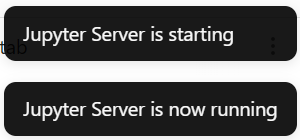Jupyter for Obsidian is a simple plugin and does basically two things:
- Run a Jupyter server for you (instead of opening a terminal and typing
jupyter [...]) - Tell Obsidian how to open
.ipynbfiles
This is a very minimal plugin, hence I’m interested in your feedback to build from here.
Starting Jupyter
Opening .ipynb files inside of Obsidian still requires you to start a Jupyter server. Good news, the plugin can handle this for you.
There are three ways for you to start a Jupyter server:
- Simply open a
.ipynbfile. By default, the plugin is configured to automatically run Jupyter before opening the file. - Use the ribbon icon, unless you have disabled it.
- Navigate to the settings of the plugin and use the Server running setting to toggle the state of the Jupyter server.
Configuring Jupyter
Choosing Between Lab and Notebook
You can open your .ipynb files using either Jupyter Lab or Jupyter Notebook, depending on your preferences. You can change this behaviour using the setting Jupyter environment type.
Choosing the Python Executable
By default, the plugin will use a simply python shell command to run Jupyter. However, if you installed Jupyter in a Python virtual environment or with Conda/Miniconda, you’ll want to change the Python executable.
You can do so by changing the setting Python executable path. If you want to use an executable path instead of the python command, you must also ensure that Python executable to use is set to Specified executable path, otherwise the python command will still be used.
In particular, if you use Conda or Miniconda, see this guide to find the executable path you should use.
Toggle Ribbon and Status Notices
By default, the plugin will show a ribbon icon allowing you to start and stop the Jupyter server in one click.
![]()
It will also display status notices to tell you how the server is doing. One will be displayed when the server is starting, running or has exited.

You can disable both the ribbon icon and the status notices individually using the two corresponding settings, if you do not find them necessary.